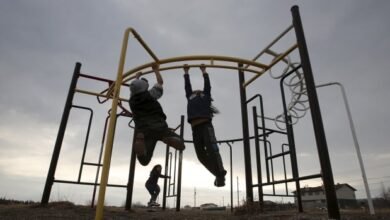I was surprised to find beauty in the aftermath of the Jasper fire

This First Person article is written by Ted Bishop, who lives in Edmonton. For more information about CBC’s First Person stories, please see the FAQ.
We evacuated west in a conga line of cars and trucks to Valemount, B.C., not knowing if our old log cabin on Lake Edith outside of Jasper, Alta., was already in flames.
Three weeks later, after the wildfire had ripped through the Jasper townsite, my 13-year-old son Thomas and I went up to check the damage, wondering if all would be ash.
The west side of the townsite looked as if the homes had not just been burned but bombed. Out at our cabin though, flying embers had scorched the grass to within five metres of the cabin. The main fire had not reached us.
We rode our bikes to the old Maligne Lake road to where the main fire had raged. Just 300 metres from the cabins.
Over the last decade the lake residents had worked with park wardens in the FireSmart program to create a defensive band. We cleared brush, hauled deadfall, cut branches on live trees up two metres from the ground and lopped the sweet-smelling juniper.
Our line had held. There were burn patches in our sector, but beyond it devastation reigned — every tree seared to a blackened stick, some reduced to stumps that barely pushed through the ash, like broken molars.
The trunks on the ground had a light reddish ash beside them, and the carbonized wood had a glaze that when it caught the sun looked like aluminum. Some huge trees had been smashed over, roots ripped out of the ground.
One had what looked like huge tentacles splaying out from it, and underneath a twisted shape that looked like the blackened headless torso and legs of a giant man.
I learned from a warden that in FireSmart we were essentially following First Nations fire practices. That’s what saved our cabin, and we were grateful. If those practices had been followed for the last 100 years the conflagration, the 100-metre high flames with pyrocumulus clouds producing new lightning strikes, might never have developed.
Fire suppression was never the answer.
Residents of Jasper, Alta., forced from their homes by a monster wildfire are returning Friday to begin sifting through the ashes of their devastated community.
Looking over the scene, Thomas said, “You can only hold Mother Nature back for so long.”
True. Narrow trees and dense brush had completely choked off the area, once an open forest where, as a kid, I’d ridden my bike and played kick-the-can with friends.
The ash floated up as we walked our bikes around the fallen trees, coating our toes (the day was warm and we wore sandals). The main bike trail would require hours of work to clear it.
Marked by the land
But now light poured in, and now in every direction mountains appeared — the soft curve of Signal, the sharp triangle of Pyramid — that had been obscured before.
All was silent and nothing moved and we talked quietly, though we didn’t have to. There was something reverent about the hush.

No one had been out here yet. There were no animal tracks, no insects. I told Thomas that one of the first things to grow would be the beautiful purple fireweed.
When we got back to the city and showered the ash off our feet the black came back the next day, though not as dark, as if it had been absorbed into our pores, and we felt proud, honoured to have been there, and to have been marked by the land.
We also knew we were lucky to still have the cabin, and to be able to offer it to a Jasper family for the winter, while they rebuild in town. And the forest rebuilds around them.
Source link




